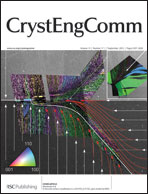Remarkable solvent-size effects in constructing novel porous 1,3,5-benzenetricarboxylate metal–organic frameworks†
Abstract
Seven novel porous metal–organic frameworks (MOFs), Zn2(BTC)(NO3)(DMA)3 (1), Zn11(BTC)6(NO3)4(DEE)9 (2), Zn11(BTC)6(NO3)4(DEP)8 (3), Zn(BTC)·DMA·C2H8N (4), Zn3(BTC)3·3(C2H8N)·4(DMA) (5), Zn9(BTC)6(OH)2·2(C2H8N)·15(DEE) (6), and Zn9(BTC)5(OH)3(C2O4)·2(C4H12N)·5(DEE) (7) have been solvothermally synthesized using zinc nitrate, 1,3,5-benzenetricarboxylate acid (H3BTC) and differently sized solvents (DMF, DMA, DEE, DEP, DPE, DPP), showing that the solvent size can not only dramatically influence the pore size, but also allow access to new structures and topologies previously unrealized in MOFs. With increasing solvent size, the pore size of MOFs correspondingly changes from 9 Å to 23 Å along with different structures: three frameworks have cages larger than 16 Å, one has a 23 Å chiral cage, five are anionic frameworks, three have topologies heretofore unreported in MOFs and all structures are noninterpenetrating. The ion-exchange experiment estimated by HNMR analyses shows that dimethylamine ions in 5 can be exchanged by NH4+ ions.


 Please wait while we load your content...
Please wait while we load your content...